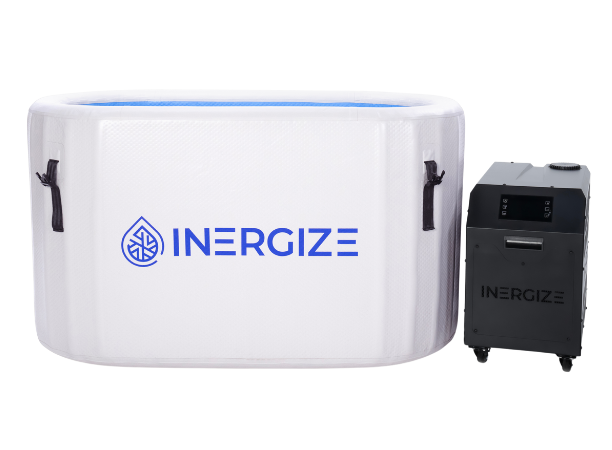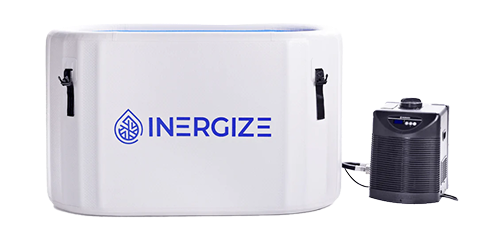How Long To Stay in a Cold Plunge?

When starting cold plunging, begin with 30 seconds to 1 minute of exposure. Gradually increase your time by 15-30 seconds per session, aiming for 2-3 minutes as you build tolerance. Listen to your body and exit if you experience uncontrollable shivering, numbness, or difficulty breathing. Consistency is key, so shorter, regular sessions are better than longer, infrequent ones. Water temperature should be between 50°F to 59°F (10°C to 15°C) for beginners. Always prioritize safety by having a spotter nearby and avoiding hot showers immediately after. As you progress, you'll discover the optimal duration that balances challenge and benefit for your unique needs.
The Science of Cold Exposure
Shock to the system: that's what cold exposure initially feels like. Your body reacts instantly, triggering a cascade of physiological adaptations. As you immerse yourself in cold water, your blood vessels constrict, redirecting blood flow to vital organs. Your heart rate increases, and you start to breathe more rapidly.
But what's happening beneath the surface? Cold exposure activates several molecular mechanisms in your body. It stimulates the production of brown adipose tissue, which helps burn calories and improve metabolism. Your body also releases norepinephrine, a hormone that can boost mood and alertness.
Cold plunges can activate your body's natural anti-inflammatory responses, potentially reducing muscle soreness and speeding up recovery after exercise. They may also enhance your immune system by increasing the production of white blood cells.
Regular cold exposure can lead to long-term adaptations. Your body becomes more efficient at maintaining core temperature, and you'll likely find it easier to tolerate cold over time. This process, known as cold acclimatization, can have lasting benefits for your overall health and well-being.
Optimal Duration for Beginners
For beginners, the optimal duration of a cold plunge is surprisingly brief. You'll want to start with short exposures and gradually increase the time as your body adapts. The acclimation process is crucial for building tolerance and reaping the benefits of cold therapy safely.
Your starting duration should be around 30 seconds to 1 minute. As you progress, aim to increase your time by 15-30 seconds each session. Remember, it's not a competition; listen to your body and exit the cold plunge if you experience:
- Uncontrollable shivering
- Numbness in your extremities
- Difficulty breathing
- Intense discomfort or pain
Consistency is key in cold plunge therapy. It's better to have shorter, regular sessions than infrequent, longer ones. As you become more accustomed to the cold, you can work your way up to 2-3 minutes per session. Don't rush the process; it may take weeks or even months to reach this point. Always prioritize safety and comfort over pushing your limits too quickly.
Advanced Cold Plunging Techniques
Once you've built up your cold tolerance, you can explore advanced cold plunging techniques to maximize the benefits. One effective method is to incorporate breath control techniques during your cold water immersion. Try the Wim Hof method, which involves controlled hyperventilation followed by breath retention while submerged. This can enhance your ability to withstand cold and potentially increase the physiological benefits.
Another advanced technique is to implement progressive cold water immersion protocols. Start by alternating between hot and cold exposures, gradually increasing the duration of cold immersion. You can also experiment with contrast therapy, moving between hot and cold water multiple times in a single session. This approach may improve circulation and reduce inflammation more effectively than cold exposure alone.
Consider combining cold plunging with other practices, such as meditation or visualization. This can help you maintain focus and push through discomfort. Additionally, you might try extending your immersion time incrementally, aiming for longer durations as your body adapts. Remember to listen to your body and exit the cold plunge if you experience extreme discomfort or numbness.
Benefits of Different Time Intervals
Various time intervals for cold plunging offer distinct benefits, each catering to different goals and tolerance levels. Short dips of 30 seconds to 1 minute can provide a quick energy boost and mild stress reduction. These brief exposures are ideal for beginners or those pressed for time.
Intermediate sessions lasting 2-3 minutes enhance muscle recovery and promote more significant stress reduction. You'll likely experience improved circulation and a noticeable mood lift.
For seasoned cold plungers, extended sessions of 5-10 minutes can lead to more profound benefits, including increased brown fat activation and potential immune system improvements.
To visualize the experience of different cold plunge durations, imagine:
- A 30-second dip: Sharp intake of breath, tingling skin
- A 2-minute plunge: Controlled breathing, feeling of invigoration
- A 5-minute session: Mental clarity, sense of accomplishment
- A 10-minute immersion: Full-body adaptation, profound calm
Safety Precautions and Time Limits
When it comes to cold plunging, safety should be your top priority. While the practice offers numerous benefits, it's crucial to adhere to proper guidelines to avoid potential risks.
First, consider proper clothing considerations. Wear a swimsuit or trunks that provide adequate coverage without restricting movement. Protect your extremities with neoprene gloves and booties if you're sensitive to cold.
Always monitor the water temperature before entering. Ideal temperatures range from 50°F to 59°F (10°C to 15°C) for beginners. As you progress, you can gradually lower the temperature. Never exceed 15 minutes in the cold plunge, regardless of your experience level. For beginners, start with 30-second to 2-minute sessions and gradually increase the duration.
Pay attention to your body's signals. If you experience intense shivering, numbness, or blue lips, exit the plunge immediately. It's essential to warm up slowly afterward to prevent shock. Use a towel or robe and avoid hot showers immediately after your plunge. Lastly, always have a spotter nearby, especially if you're new to cold plunging or have any underlying health conditions.
Personalizing Your Cold Plunge Routine
When personalizing your cold plunge routine, it's crucial to assess your individual tolerance level. Start with shorter durations and cooler, rather than ice-cold, temperatures to gauge your body's response.
As you become more accustomed to the practice, you can gradually increase your exposure time and lower the water temperature to maximize the benefits of cold plunging.
Assess Your Tolerance Level
Your body's response to cold exposure is unique, making it essential to assess your personal tolerance level before diving into a cold plunge routine. Start by immersing yourself in cold water for short periods, perhaps 30 seconds to a minute, and gradually increase the duration as you become more comfortable.
Pay attention to your body's reactions, including:
- Shivering intensity
- Skin color changes
- Breathing patterns
- Mental clarity or discomfort
As you continue your cold plunge practice, you'll notice your tolerance improving. Keep monitoring progress by tracking the duration of your sessions and how your body responds over time. Building tolerance is a gradual process, so be patient and consistent with your practice.
It's crucial to listen to your body and never push beyond your limits. If you experience severe discomfort, numbness, or difficulty breathing, exit the cold water immediately. Remember that everyone's tolerance level is different, and there's no one-size-fits-all approach to cold plunging. By regularly assessing your tolerance and adjusting your routine accordingly, you'll create a safe and effective cold plunge practice tailored to your individual needs.
Gradually Increase Exposure Time
To personalize your cold plunge routine, gradually increasing exposure time is key. Start with short durations, perhaps just 30 seconds to a minute, and slowly extend your stays as you become more comfortable. This acclimation process allows your body to adapt to the cold stress without overwhelming your system.
Pay attention to your body's signals during each session. As you progress, you'll notice that you can tolerate longer exposures. This is partly due to cold receptor adaptation, where your nervous system becomes less sensitive to the initial shock of cold water. Aim to increase your time by 15-30 seconds each session or week, depending on your comfort level.
Set realistic goals for yourself. While some experienced practitioners may stay in cold water for several minutes, it's not a race. Your ideal exposure time will depend on factors like water temperature, your physical condition, and your specific health goals. Remember, consistency is more important than duration. Regular short plunges can be just as beneficial as occasional longer ones. Always prioritize safety and listen to your body throughout the process.
Cold Plunge Vs. Ice Bath
Cold plunges and ice baths are often used interchangeably, but they're not exactly the same thing. The main difference lies in the temperature and setup. A cold plunge typically involves immersion in water between 35-55°F (1-12°C), while an ice bath is much warmer, usually around 50-59°F (10-15°C).
Cold plunges are generally more accessible and can be done more frequently. You can aim for a cold plunge temperature of around 55°F (13°C) and maintain a cold plunge frequency of 2-3 times per week.
To visualize the differences, consider these aspects:
- Temperature: Cold plunge feels brisk, while an ice bath is intensely cold
- Duration: You can stay longer in a cold plunge compared to an ice bath
- Recovery: Cold plunges aid in daily recovery, ice baths for intense workouts
- Comfort: Cold plunges are more tolerable for beginners
Both methods offer benefits, but cold plunges are generally safer and more sustainable for regular use. Choose based on your goals, tolerance, and experience level.
Frequently Asked Questions
Can I Eat Before or After a Cold Plunge?
You can eat before or after a cold plunge, but consider fasting before for better results. After your plunge, focus on hydration. It's essential to listen to your body and adjust your eating habits accordingly for optimal benefits.
How Often Should I Do Cold Plunges for Optimal Results?
You'll get optimal results by doing cold plunges 2-3 times a week. Start with short 1-2 minute sessions and gradually increase to 5-10 minutes. Aim for water temperatures between 50-59°F (10-15°C) for the best benefits.
What's the Best Time of Day for a Cold Plunge?
You'll get the most benefits from a cold plunge in the morning. It'll energize you for the day ahead. Aim for an optimal temperature range of 50-59°F (10-15°C). Keep your time of immersion between 2-5 minutes for best results.
Can I Use Cold Plunges to Treat Specific Injuries or Conditions?
Yes, you can use cold plunges to treat specific injuries or conditions. They're great for improving muscle recovery and reducing inflammation. You'll find them especially helpful for sports injuries, muscle soreness, and joint pain. Always consult your doctor first.
How Do I Mentally Prepare for a Cold Plunge Session?
To mentally prepare for a cold plunge, focus on controlled breathing techniques. Visualize your desired mental state, staying calm and centered. Remind yourself of the benefits you'll gain. Set a clear intention and embrace the challenge with a positive mindset.
Conclusion
You've now got the tools to tailor your cold plunge experience. Remember, there's no one-size-fits-all duration. Start slow, listen to your body, and gradually increase your time as you build tolerance. Whether you're dipping for 30 seconds or pushing for several minutes, you'll reap benefits. Always prioritize safety and don't overdo it. With consistent practice, you'll find your sweet spot and maximize the advantages of cold exposure for your health and wellness.






